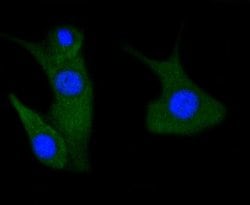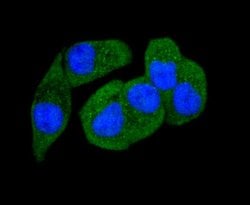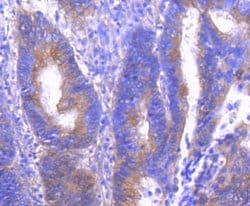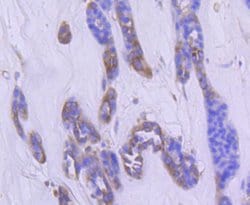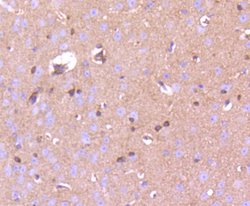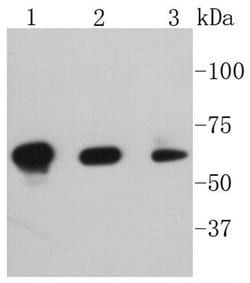Learn More
Invitrogen™ Phospho-PAK1/2/3 (Ser144, Ser141, Ser139) Recombinant Rabbit Monoclonal Antibody (SU03-70)


Rabbit Recombinant Monoclonal Antibody
Supplier: Invitrogen™ MA532130
Description
Recombinant rabbit monoclonal antibodies are produced using in vitro expression systems. The expression systems are developed by cloning in the specific antibody DNA sequences from immunoreactive rabbits. Then, individual clones are screened to select the best candidates for production. The advantages of using recombinant rabbit monoclonal antibodies include: better specificity and sensitivity, lot-to-lot consistency, animal origin-free formulations, and broader immunoreactivity to diverse targets due to larger rabbit immune repertoire.
In mammals, there are several identified isoforms of p21-Activated Protein Kinases or PAKs: alpha-PAK (also known as PAK-1) and beta-PAK (also known as PAK-3) are mostly brain-specific, while gamma-PAK (also known as PAK-2) is expressed ubiquitously (Jakobi et al., 2003). Mutations of the gene coding for PAK-3 are associated wit X-linked mental retardation and recent work indicates that PAK-3 is a key regulator of synapse formation and plasticity in the hippocampus (Boda et al., 2004). PAK-3 is thought to play a key role in regulation of cell shape and motility as well as cell death (Jakobi et al., 2003; Walter et al., 1998). Autophosphorylation of Thr402 in the protein has been found to be essential for activation of PAK (Jakobi et al., 2000).
Specifications
| Phospho-PAK1/2/3 (Ser144, Ser141, Ser139) | |
| Recombinant Monoclonal | |
| 1 mg/mL | |
| TBS with 0.05% BSA, 40% Glycerol and 0.05% sodium azide; pH 7.4 | |
| O75914, O88643, P35465, Q13153, Q13177, Q61036, Q62829, Q64303, Q8CIN4 | |
| Pak1, PAK2, PAK3 | |
| Synthetic phospho-peptide corresponding to residues surrounding Ser144 of Human PAK1 aa 121-150. | |
| 100 μL | |
| Primary | |
| Human, Mouse, Rat | |
| Antibody | |
| IgG |
| Flow Cytometry, Immunohistochemistry (Paraffin), Western Blot, Immunocytochemistry, Western Blot | |
| SU03-70 | |
| Unconjugated | |
| PAK3 | |
| 5330420P17Rik; A130002K10Rik; activated protein kinase alpha; ADRB2; adriamycin resistance-associated; AI836325; Alpha-PAK; ARA; AW045634; Beta-PAK; bPAK; CDC42/RAC effector kinase PAK-A; CDC42/RAC effector kinase PAK-B; CDKN1A; C-t-PAK2; D16Ertd269e; EC 2.7.11.1; gamma pak; gamma-PAK; hPAK3; kinase PAK1; mKIAA4182; MRX30; MRX47; oligophrenin-3; OPHN3; p21 (CDKN1A)-activated kinase 1; p21 (CDKN1A)-activated kinase 2; p21 (CDKN1A)-activated kinase 3; p21 (RAC1) activated kinase 1; p21 (RAC1) activated kinase 2; p21 (RAC1) activated kinase 3; p21 protein (Cdc42/Rac)-activated kinase 1; p21 protein (Cdc42/Rac)-activated kinase 2; p21 protein (Cdc42/Rac)-activated kinase 3; p21/Cdc42/Rac1-activated kinase 1 (STE20 homolog, yeast); p21/Cdc42/Rac1-activated kinase 1 (yeast Ste20-related); p21/Cdc42/Rac1-activated kinase 3 (yeast Ste20-related); p21-activated kinase 1; p21-activated kinase 2; p21-activated kinase 3; p27; p34; p58; p65-PAK; p68-PAK; PAK 1; PAK alpha; PAK beta; PAK gamma; Pak1; PAK-1; Pak2; PAK-2; PAK-2p27; PAK-2p34; PAK3; PAK-3; PAK3beta; PAK65; Pak65alpha; Pak65beta; Paka; PAKalpha; Pakb; PAKgamma; Protein kinase MUK2; S6/H4 kinase; Serine/threonine-protein kinase PAK 1; serine/threonine-protein kinase PAK 2; Serine/threonine-protein kinase PAK 3; STE20 homolog, yeast; Stk4 | |
| Rabbit | |
| Protein A | |
| RUO | |
| 18479, 18481, 224105, 29431, 29432, 29433, 5058, 5062, 5063 | |
| Store at 4°C short term. For long term storage, store at -20°C, avoiding freeze/thaw cycles. | |
| Liquid |
Your input is important to us. Please complete this form to provide feedback related to the content on this product.
